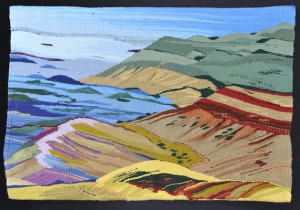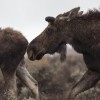Fiber artist Doris Florig weaves natural history in her tapestries
“While experimenting with natural dye materials for the pronghorn coat, I tried banana leaves and cinnamon bark,” Doris Florig writes in an email from a sailboat in the Caribbean. “The result was beautiful but too green… tomorrow I will work again on the colors for the coat. This time I will try cinnamon bark and black tea.”

Florig is thousands of miles from her other home in Wyoming, where she is the artist-in-residence for the Kelly campus of the Teton Science School. Her work reflects her own migrations around the world. As she travels, she weaves and creates fiber art, incorporating the natural world through her subject matter and materials.
Florig grew up outside of Philadelphia and graduated from the University of Tampa in 1971. She and her husband, Dennis Clancy, immigrated to a remote region of northern Ontario, established a family farm, and learned self-sufficiency. Far from restaurants and movies, social gatherings consisted of evenings with friends making things, especially music, art, and food. “Being surrounded by practical and creative people, inspired me to learn to spin wool and to weave on handmade portable looms,” she says.
In the 80’s Florig and Clancy returned to the US, and they moved West in 2005 to be near their children and grandchildren. During a natural dye demonstration at the Jackson Hole Historical Society and Museum, the associate director of the Teton Science Schools invited Florig to lead a hands-on natural dye workshop for the students. Florig soon set up a studio at the school’s Kelly, Wyoming, campus, where she is the latest in a long tradition of artists in residence.
Campus visitors wander through her studio, and Florig introduces them to the connection between fiber arts and the environment, showing how she gathers materials for her work from the natural world. She demonstrates how to make natural dyes as well as weaving.

This will be her third summer on the Kelly campus, a collection of rustic log cabins located inside Grand Teton National Park. The Grand Tetons and the Gros Ventre Mountains frame the school, which faces wide sage flats and the Snake River. The school’s educational philosophy embraces place-based education, using the local community and surrounding environment as learning resources for the students.
For Florig, being in Kelly is a natural fit. She even takes inspiration from her daily drive to Kelly from Jackson. “It is a commute that should take about a half hour but it usually takes me about an hour and a half. The spring is especially interesting because the pronghorn are arriving and the herds of bison are appearing with their young.”
Florig’s work includes life-sized fiber sculptures of animals native to the wild land between Yellowstone and the Yukon. She is working on a tapestry of Yellowstone Lake inspired by the works of the nineteenth century Yellowstone landscape painter Thomas Moran. Her next project, started on her sailboat over the winter, will be The Path of the Pronghorn. The “tapestry will be an abstract map of their path through the mountains,” she says. Pronghorn that summer and fawn near the Kelly campus in Grand Teton National Park travel almost 150 miles southwest to the Green River Valley for the winter, along the way passing housing subdivisions, gas patches, fences, and highways. Florig, inspired by their journey, has been gathering plants and minerals from the migration corridor and elsewhere to dye the yarn for the tapestry.
She’ll continue the project once she returns to Kelly. First, she will finish her winter in Central America and then travel in her camper van from the East coast to Wyoming, gathering bark, tea, and leaves to add to her dye pot inventory en route.
She travels with a small nomadic style loom and weaves everywhere she goes, even in the car while her husband drives. Like the pronghorn in her tapestry, Florig migrates with the seasons, weaving across the land, finding inspiration in unexpected places.
By Nina McConigley
Nina McConigley is a writer and assistant professor in the University of Wyoming Honors Program.


